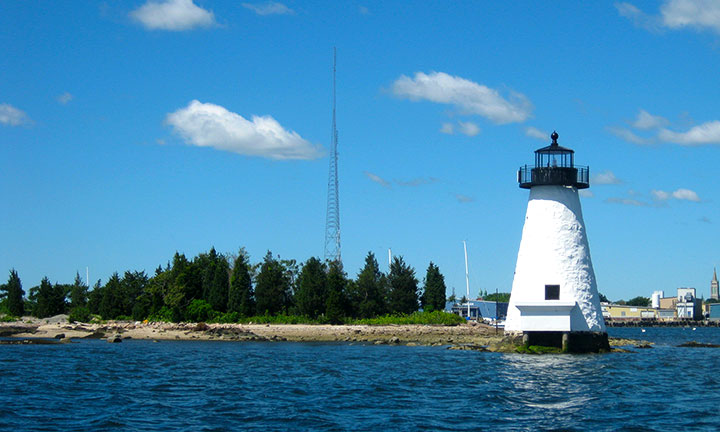
Palmer’s Island
, New Bedford, MA 02740
Share this listing
Located in the Acushnet River at the entrance to New Bedford Harbor, this 6-acre island is designated for walking and other passive recreational uses, such as bird watching.
History of Palmer’s Island
Pre-dating the Pilgrims’ arrival in Plymouth by 18 years, English explorer Bartholomew Gosnold first surveyed the 6-acre island during his exploration of New Bedford Harbor in 1602. The island was later named after William Palmer, an original settler of Old Dartmouth. The island was used as an internment camp for Native Americans during King Phillip’s War (1675-1676) and as a garrison during the Revolutionary War. A hotel and amusement park were built during the 19th century. During the 1938 Hurricane all the structures on the island were washed away with the exception of the lighthouse.
Habitat Restoration on Palmer’s Island
Habitat restoration on Palmers Island has been funded by the New Bedford Harbor Trustee Council for damages to natural resources and lost uses as a result of PCB contamination in the New Bedford Harbor Environment.
Restoration includes the removal of invasive Oriental Bittersweet and Sweet Autumn Clematis vines that climb throughout open areas and native shrub and tree habitat at the north end of the island.
Common Reed is also an invasive plant that colonizes wetlands such as the salt marsh in the center of the island and is mowed and treated with herbicide. Native species plantings will help to re-vegetate the edge of this wetland.
Palmer’s Island Passive Recreation
Palmer’s Island is designated for walking and other passive recreational uses such as bird watching. Fishing and shell fishing are prohibited due to the contamination of the harbor with PCBs. Hunting is not permitted. Metal detecting, digging and artifact collecting are also prohibited per Mass Gen. Law c. 9 s. 27C. Please carry all of your trash off of the island for disposal.
Please be aware of the Poison Ivy, Cow Parsnip, ticks and mosquitoes on the island. Stay on the designated trails or on the west beach. Check the tide charts to be sure you are out on the island during low tide. Be aware of rising tides as access from the sand-spit at the southern end of the island may be covered with several feet of water and treacherous to cross outside of low tide.
Palmer’s Island Lighthouse
The 24-foot tall stone lighthouse was commissioned during the peak of the whaling era to guide ships into the harbor. It was first lit on August 30, 1849 using whale oil. Palmer’s Island Lighthouse is a central element of the City Seal designed in 1853, with the motto, Lucem Diffundo, meaning, I Diffuse Light , referring to the City’s dominance in the provision of whale oil for illumination. Upon completion of the Hurricane Barrier in 1966, the lighthouse was deemed obsolete and the City of New Bedford took over ownership in 1978.
The most famous lighthouse keeper was Arthur Small who served from 1922 until the Hurricane of 1938. During the Hurricane, Small was swept into the harbor and his wife Mabel attempted a rescue by row boat. Small survived the storm but his wife perished.
Flora and Fauna
Native coastal scrub-shrub habitat covers much of the upland with abundant Bayberry shrubs, Staghorn Sumac and woody Poison Ivy. Deciduous trees such as Red Maple, Black Oak and Pin Cherry are interspersed within this scrub-shrub habitat. A small Eastern Red Cedar grove is situated at the northern end of the island. A marsh dominated by the invasive Common Reed has undergone restoration in the center of the island. Other marshes include a high salt marsh dominated by Salt Marsh Hay bordering the western beach, and a pocket of low salt marsh with Salt Marsh Cordgrass and Sea Lavender growing in the intertidal zone on the east side of the island.
Osprey have built a nest on a pole at the northern end of the island. A fish eating hawk, this bird has made a significant recovery since the ban of DDT in 1972. The Eastern Cottontail seeks food and cover in the scrub-shrub habitat and feeds in the high marsh on the island. A variety of songbirds including the American Goldfinch, Song Sparrow, and Northern Mockingbird utilize the open island habitats. Wading birds such as the American Oystercatcher and Great Blue Heron can be seen feeding in the intertidal zone. Herring Gulls are a common sight along the shoreline.
Native American Historic Presence of Palmer’s Island
Members of the Wampanoag Nation visited and camped on Palmer’s Island prior to European colonization. The Wampanoag harvested and processed shellfish along the intertidal zone by drying and smoking them for winter meals. They also gathered cedar from an upland grove. Cedar saplings were used for fabricating the framework of lodges, and cedar mats were woven from the bark. Cedar repels insects which made it ideal for use in the lodges.
During King Phillip’s War (1675-1676), the island was sadly an internment camp for local Native American captives.
Own This Listing? Click Here to Request an Update.
City: New Bedford